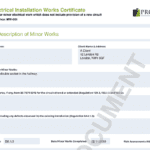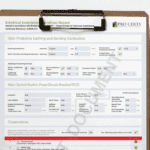The four main Condition Report observation codes are Code 1 (C1), Code 2 (C2), Code 3 (C3) and Further Investigation (FI).
C1 = Danger present
A code 1 observation must be rectified and made safe without delay.
An example of a C1 observation (it’s dangerous now!) would be the cover of a consumer unit missing hence exposing live parts. Any exposed live parts such as an open consumer unit busbar or an exposed live cable end would be classed as a code 1, as it is dangerous (right now) at the time of the inspection.
C2 = Potentially dangerous
A code 2 observation must be rectified as a matter of urgency.
An example of a C2 observation (potentially dangerous) would be no RCD protection to an external 13A socket. A C2 potentially dangerous observation extends to any potential dangers, hazards or risks which could occur under certain conditions or under fault conditions such as, this could become dangerous should that happen.
C3 = Improvement recommended
A C3 observation is your recommendation for improvement.
A code 3 would be an observation you feel warrants a mention on the report of something you feel should be improved but would not be classed as a C1, C2 or FI.
FI = Further investigation required
An FI observation must be investigated as a matter of urgency.
Further investigation would be allocated to an observation which could be potentially dangerous but could not be determined at the time of the inspection, therefore requires further investigation into the defect to be able to determine what code to allocate against it.
EICR Pass or Fail?
It is the responsibility of the person carrying out the inspection and testing to determine and allocate either a C1, C2, C3 or FI to each defect / non-compliance found (if any) in their professional judgement.
Professional judgement means the application of relevant training, knowledge and experience, within the context provided by auditing, accounting and ethical standards, in making informed decisions about the courses of action that are appropriate in the circumstances of the audit engagement.
There are only two outcomes of an Electrical Installation Condition Report formally known as a Periodic Inspection Report (PIR), they are SATISFACTORY and UNSATISFACTORY (for continued use).
If an observation has been allocated either a C1, C2 or FI code then the installation must be deemed to be unsatisfactory. If no code 1’s, 2’s or FI’s have been noted but a number of code 3 observations have been made then the installation can be deemed to be satisfactory as long as the inspection and testing has been carried out thoroughly and there are not too many limitations (LIM) applied.
An Electrical Installation Condition Report which has been deemed as Unsatisfactory is essentially a fail, meaning at least one C1, C2 or FI observation has been identified.
An Electrical Installation Condition Report which has been deemed as Satisfactory is essentially a pass, however the electrical inspector may have identified items for which they recommend improvement (C3).
EICR Limitations
Many inspection reports may include “LIM” meaning a limitation has been applied to the inspection.
LIM = Limitation (not tested or inspected)
A limitation (LIM) noted on a condition report means that a particular item(s) and / or circuit(s) have not been tested or inspected. This could be due to no access to a particular area of the installation such as a server room, therefore the circuit supplying the server room could not be tested or inspected hence a limitation has been applied.
Another example of a limitation could include high level warehouse lighting, if there is no safe working access to the high level lighting then a limitation might be applied.
The Work at Height Regulations 2005 apply to all work at height, where there is risk of a fall liable to cause personal injury. They place duties on employers, and those who control any work at height activity (such as facilities managers or building owners who may contract others to work at height)
If an electrical installation which contains any limitations has been assessed to be satisfactory, the satisfactory assessment is subject to the limitations contained within the report, meaning the satisfactory condition is only applicable to the circuits which have actually been tested and inspected and does not include the limitations applied.





